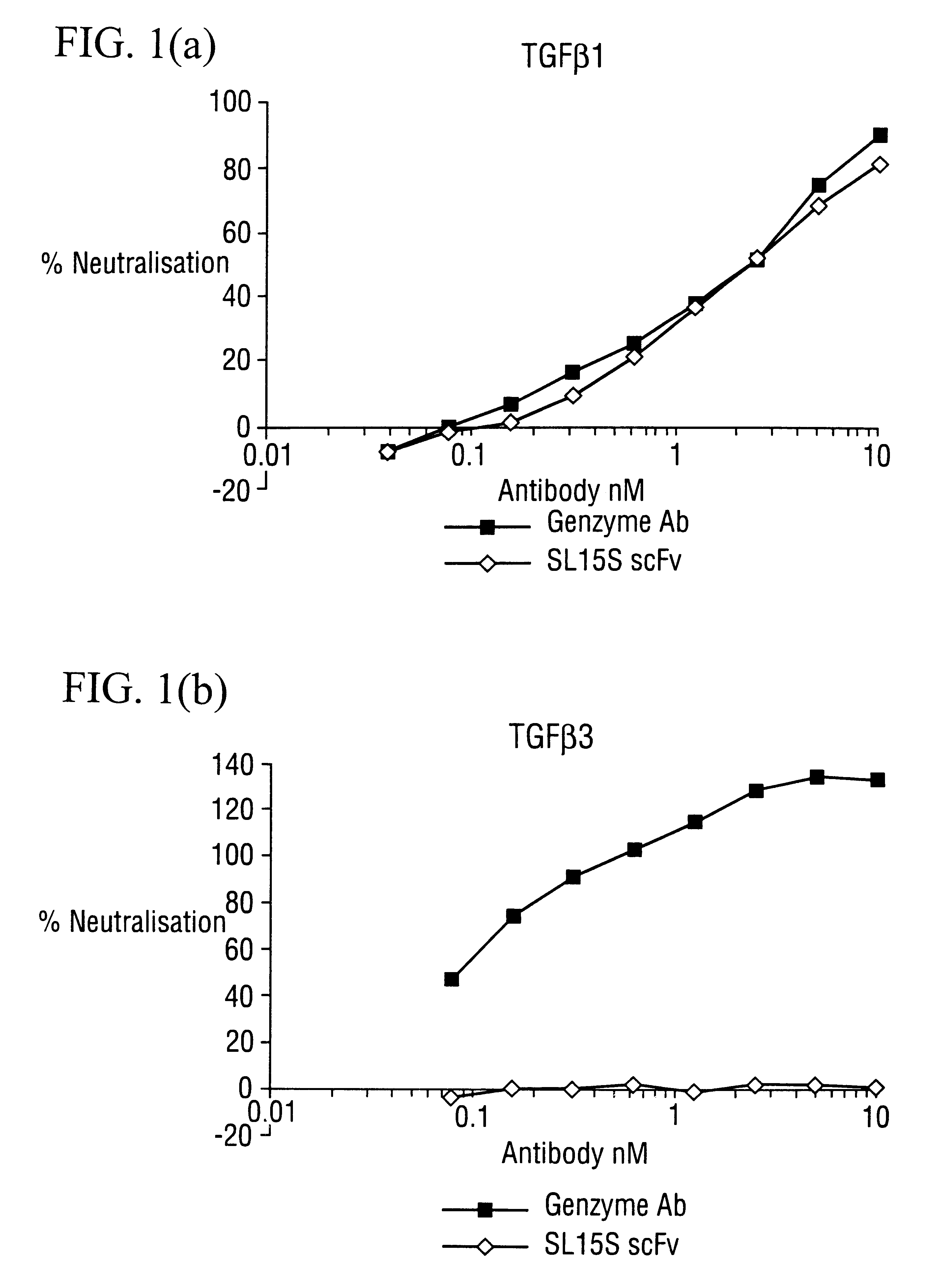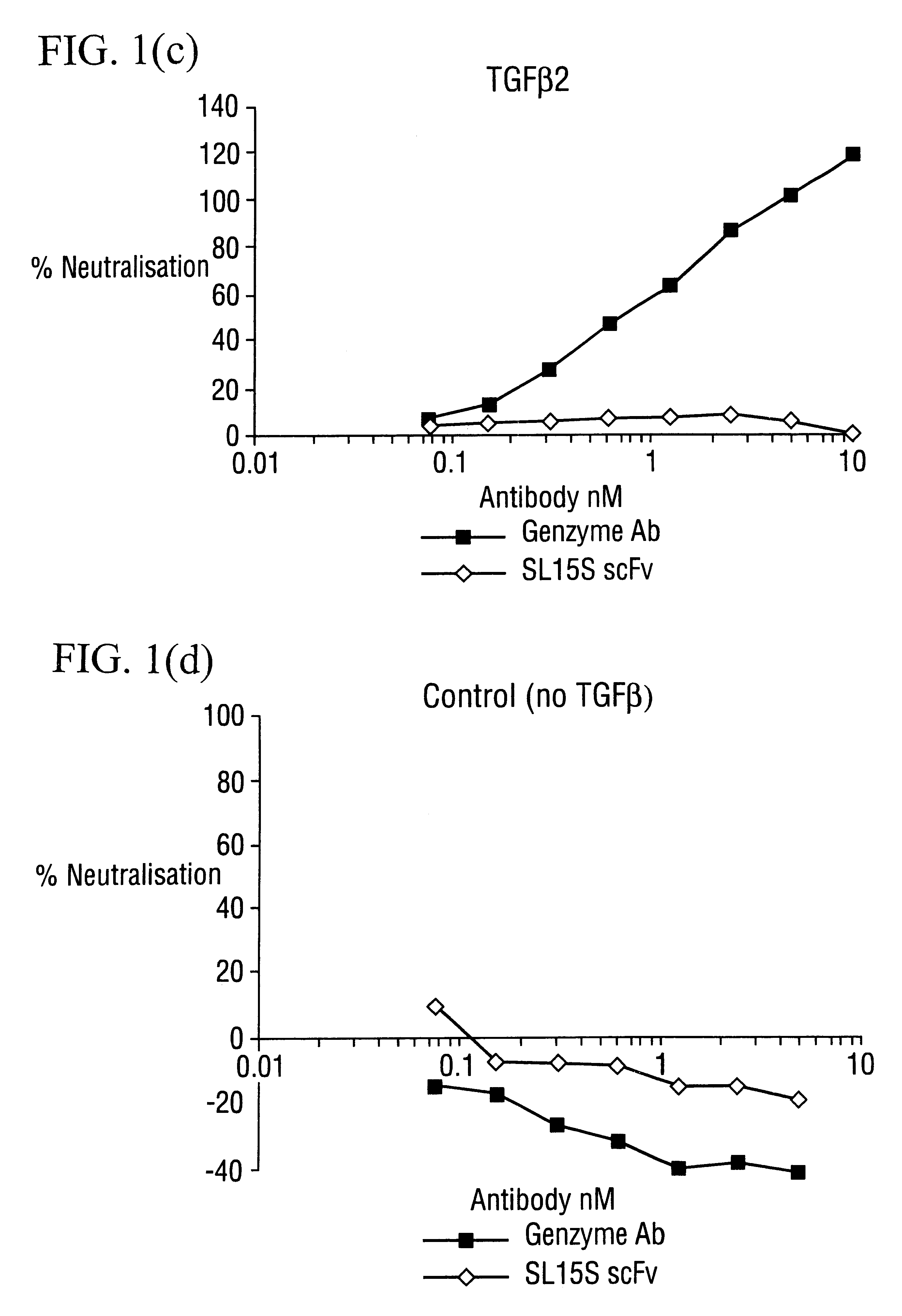Specific binding members for TGFbeta1
a technology of tgfbeta and specific binding members, which is applied in the direction of antibody medical ingredients, drug compositions, immunological disorders, etc., can solve the problems of melanoma lung metastasis, poor prognosis, and inability to explain many features of inflammation, etc., and achieve the effect of i.v. inoculation but not as effectiv
- Summary
- Abstract
- Description
- Claims
- Application Information
AI Technical Summary
Problems solved by technology
Method used
Image
Examples
example 1
Identification of SL15S SCFV (CAT-191) and JT182
The present inventors have identified antibody CDRs and VH and VL domains related to those of the CS37 antibody disclosed in WO97 / 13944, but with unexpectedly good properties.
The CS37 VH (31 G9) domain sequence and encoding nucleic acid therefor are shown in SEQ ID NO:2 and SEQ ID NO:1, respectively.
The SL15 (a.k.a. KYLIE) VH domain sequence of the present invention and encoding nucleic acid therefor are shown in SEQ ID NO:4 and SEQ ID NO:3, respectively.
The respective VH CDR3 sequences are shown in Table 1, also Table 2 which includes CDR1 and CDR2 sequences for both VT and VL domains.
Comparison of CS37 (31 G9) and SL15 (Kylie) VH domains shows three further differences in framework residues, at residues 1 (glutamine CS37 to glutamate SL15), 6 (glutamine CS37 to glutamate SL15) and 44 (glycine CS37 to glutamate SL15).
The SL15 VH domain may be paired with different VL domains, and two such SL15 variants have been identified. One, known...
example 2
Construction of Cell Lines Expressing the Antibody SL15A IGG4 (CAT-192) and SL15S IGG4 (CAT-193)
For the construction of cell lines expressing human IgG4,.kappa. antibodies, SL15 scFV heavy and light chain variable domains were cloned into mammalian expression vectors containing human IgG4 and human kappa constant domains respectively. Two versions were prepared, SL15A IgG4 (CAT-192) and SL15S IgG4 (CAT-193). The antibodies are also termed Kylie IgG.
The VH from the SL15S scFv DNA was PCR-amplified with oligonucleotides P80 (SEQ ID NO:25) and P64 (SEQ ID NO:22) and joined by overlapping PCR to a 159 bp DNA fragment containing a signal sequence, splice sites and intron from M13VHPCR1 (Orlandi et al., 1989, Proc. Natl. Acad. Sci. USA 86:3833-3837) using oligonucleotides P10 (SEQ ID NO:20) and P64 (SEQ ID NO:22). The 558 bp PCR product was cut with HindIII and ApaI and cloned into HindIII-ApaI cut pGamma4 (obtained from Lonza Biologics). Ligated DNA was trans...
example 3
Assessment of Neutralisation Properties of SL15S SCFV (CAT-191) and SL15A IGG4 (CAT-192) and SL15S IGG4 (CAT-193)
The potency of neutralisation of TGF.beta..sub.1 was measured for SL15S scFv (Kylie scFv) and its derivatives using a radioreceptor assay and a cell proliferation assay (TF1).
Materials
[.sup.125 I]TGF.beta..sub.1 was supplied by Amersham (specific activity range 800-2200 Ci / mmol). Recombinant human TGF.beta..sub.1, .beta.2, .beta..sub.3, latent TGF.beta..sub.1, GM-CSF and IL-5 were obtained from R&D Systems (Minneapolis USA). Genzyme murine mAb against TGF.beta..sub.1, .beta..sub.2 and .beta..sub.3 was obtained from Genzyme (Cambridge, Mass., USA). The TF1 cell line was supplied by Robin Thorpe (NIBSC, UK) and cultured as detailed below. The A549 human lung epithelial carcinoma cell line was obtained from ATCC and grown in DMEM with 10% FCS and 2 mM glutamine. All other reagents were supplied by Sigma.
Methods
Radioreceptor Assay
A549 cells were seeded into 24-well plates at ...
PUM
| Property | Measurement | Unit |
|---|---|---|
| Molar density | aaaaa | aaaaa |
| Molar density | aaaaa | aaaaa |
Abstract
Description
Claims
Application Information
 Login to View More
Login to View More - R&D
- Intellectual Property
- Life Sciences
- Materials
- Tech Scout
- Unparalleled Data Quality
- Higher Quality Content
- 60% Fewer Hallucinations
Browse by: Latest US Patents, China's latest patents, Technical Efficacy Thesaurus, Application Domain, Technology Topic, Popular Technical Reports.
© 2025 PatSnap. All rights reserved.Legal|Privacy policy|Modern Slavery Act Transparency Statement|Sitemap|About US| Contact US: help@patsnap.com



